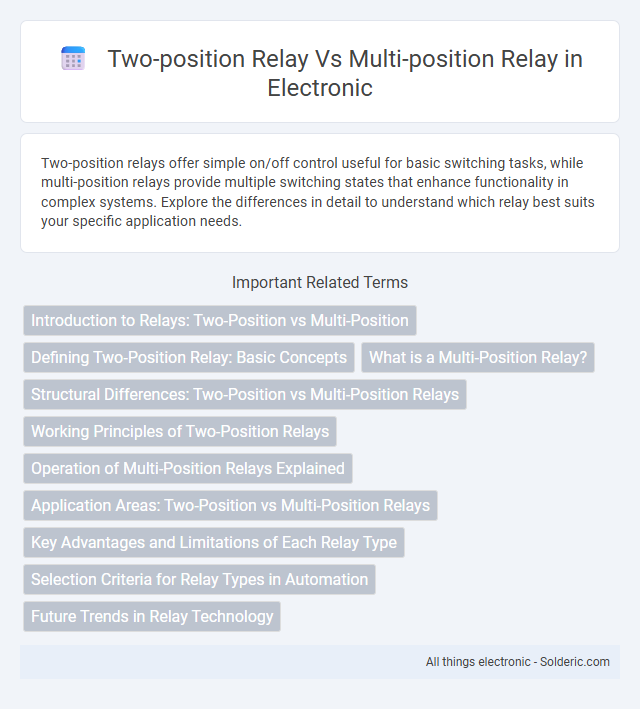Two-position relays offer simple on/off control useful for basic switching tasks, while multi-position relays provide multiple switching states that enhance functionality in complex systems. Explore the differences in detail to understand which relay best suits your specific application needs.
Comparison Table
| Feature | Two-Position Relay | Multi-Position Relay |
|---|---|---|
| Number of Positions | 2 (On/Off) | Multiple (3 or more states) |
| Functionality | Simple switching between two states | Switches among several states or circuits |
| Complexity | Low | Higher due to multiple contacts |
| Applications | Basic control, On/Off operations | Complex control systems, multi-state switching |
| Cost | Lower | Higher |
| Size | Compact | Typically larger |
| Contact Configuration | Single pole-double throw (SPDT) or similar | Multi-pole multi-throw (e.g., 3PDT) |
| Control Signal | Single coil activation | Single or multiple coils, depending on design |
Introduction to Relays: Two-Position vs Multi-Position
Two-position relays operate with a simple on/off or open/closed contact configuration, making them ideal for straightforward switching tasks such as controlling circuits or signaling alarms. Multi-position relays offer multiple contact states, enabling more complex circuit control, including sequential operations and multi-level signal routing. These varying configurations in relay design enhance flexibility and functionality in industrial automation and electrical control systems.
Defining Two-Position Relay: Basic Concepts
A two-position relay operates with only two distinct states: ON or OFF, enabling simple binary control in electrical circuits. This basic concept focuses on switching a device between two positions, making it ideal for applications requiring straightforward, reliable operation. Your choice between a two-position and multi-position relay depends on the complexity of control needed in the system.
What is a Multi-Position Relay?
A multi-position relay is an electrical device designed to switch between three or more discrete positions or circuits, enabling complex control functions beyond the simple ON/OFF states of a two-position relay. This type of relay allows Your system to selectively engage multiple outputs or inputs, providing enhanced flexibility in automation and control applications. Compared to two-position relays that toggle between two fixed states, multi-position relays offer improved versatility for managing multiple circuits with a single control signal.
Structural Differences: Two-Position vs Multi-Position Relays
Two-position relays feature a straightforward structure with a single set of contacts that switch between two fixed states, typically ON and OFF. Multi-position relays incorporate multiple contact sets or poles, enabling them to switch among three or more states, providing greater versatility in complex control applications. Understanding these structural differences allows you to select the appropriate relay based on the required switching complexity and control precision.
Working Principles of Two-Position Relays
Two-position relays operate by switching between two distinct states: ON and OFF, controlled by a single coil energization that creates a magnetic field to move the contact arm. This simple working principle ensures a binary response ideal for applications requiring straightforward control, such as power switching or signal routing. Your system benefits from the reliability and speed of two-position relays when precise, unambiguous actuation is needed.
Operation of Multi-Position Relays Explained
Multi-position relays operate by switching a common contact between multiple output contacts, allowing for more complex control circuits compared to two-position relays which simply toggle between two states. These relays use a stepped rotor or multiple coils to shift the contact arm through several stable positions, enabling precise sequential or multi-level switching in applications such as industrial automation. The operation mechanism of multi-position relays enhances system flexibility by accommodating numerous output configurations without requiring additional relay units.
Application Areas: Two-Position vs Multi-Position Relays
Two-position relays are commonly used in simple on/off control applications such as lighting circuits and motor starters, where only two states--energized or de-energized--are required. Multi-position relays find their application in complex control systems like HVAC units and industrial automation, where multiple switching states enable precise control and sequencing. Your choice between these relays depends on the complexity of the control logic and the number of output states needed for your system.
Key Advantages and Limitations of Each Relay Type
Two-position relays offer simplicity, faster switching times, and cost-effectiveness, making them ideal for basic on/off control applications, but they are limited by their binary output states. Multi-position relays provide greater versatility with multiple output options, enabling complex control schemes and finer adjustment in systems, though they tend to be more expensive and have slower response times. Your choice depends on balancing the need for simplicity and speed against flexibility and functionality in relay applications.
Selection Criteria for Relay Types in Automation
Selection criteria for relay types in automation depend on the complexity of the control system and the required switching functions. Two-position relays are ideal for simple on/off operations due to their straightforward design and reliability, whereas multi-position relays offer versatile switching capabilities suitable for complex sequences and multi-circuit controls. Factors influencing the choice include the number of switching contacts, voltage and current ratings, response time, and application-specific requirements such as safety protocols and system scalability.
Future Trends in Relay Technology
Future trends in relay technology emphasize enhanced precision and adaptability, with multi-position relays gaining prominence due to their ability to handle complex switching requirements in smart grids and automation systems. Advances in solid-state relay materials and integration with IoT enable faster, more reliable switching compared to traditional two-position relays, supporting real-time monitoring and predictive maintenance. Increased demand for energy efficiency and miniaturization drives the development of multi-position relays featuring low power consumption and compact design suited for emerging electric vehicle and renewable energy applications.
two-position relay vs multi-position relay Infographic

 solderic.com
solderic.com